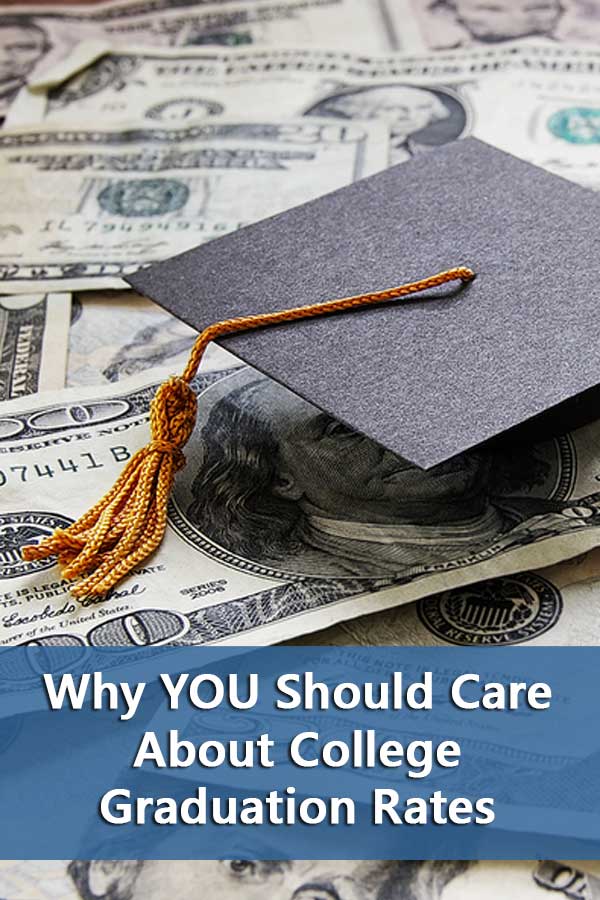 When high school students start looking for colleges to apply to, they rarely consider college graduation rates. Even with the sky-rocketing costs of college, most families still don’t consider graduation rates. They may notice it when a school advertises its four-year graduation guarantee but I suspect most just dismiss it as not applying to “their” situation.
When high school students start looking for colleges to apply to, they rarely consider college graduation rates. Even with the sky-rocketing costs of college, most families still don’t consider graduation rates. They may notice it when a school advertises its four-year graduation guarantee but I suspect most just dismiss it as not applying to “their” situation.
But college graduation rates are misleading!
Then you have voices in the media from experts who claim that college graduation rates are misleading. The reasons include:
- They don’t actually measure the value of the degree.
- They are more of a reflection of a college’s inputs rather than any affect the college may have on the student.
- They don’t reflect the fact that an increasing number of students are no longer “traditional” 18 year-olds attending a residential college full-time.
- They don’t track transfers in or out of a college.
- They don’t account for the variation of the quality and preparation of the students at different colleges and universities.
I’m sure there are reasons I’ve missed and most of them are legitimate concerns in terms of evaluating a college’s ability to graduate students.
Click HERE for list of colleges with at least a 50% graduation rate
It is kind of funny though. I spent my graduate school years looking at high school graduation rates and let me tell you, having poor, academically unprepared students with significant outside distractions didn’t cut the high schools any slack. And most high schools don’t get to pick their students, much less charge them to attend class.
Do you have a traditional college student?
So let me tell you why YOU should care.
First, the YOU I’m talking about is the family that is preparing to send their 18 year-old high school graduate to a full-time college expecting to only pay for four-years of attendance to avoid soul-crushing debt.
That YOU is exactly the YOU that is measured by current college graduation rates.
Unfortunately, the graduation rates commonly reported are the six-year rate for four-year degrees but it’s a start.
Who is responsible for transfers?
For YOU, the argument that the rate doesn’t track transfers is irrelevant. Why? Because transferring, for whatever reason, tends to be an expensive business in that not all courses transfer or that transfer students don’t generally qualify for as much financial aid. (This is not referring to starting off at a community college and transferring to a 4-year institution.)
Of course, there are always mismatches and students will need to transfer through no fault of the college. But if there is such a high number of transfers that it’s affecting the graduation rate, then the college has to take some responsibility since it admitted them.
A colleague of my husband was adjunct faculty at a private college with a low graduation rate. She said that the school explained the low rate was the result of so many of their students being first generation college students and that most who left the college eventually graduated from the local public university.
I’m pretty sure that explanation doesn’t show up in its admissions presentations.
It isn’t as if this school was providing tremendous financial aid for the students. These students were encouraged to take out large loans for a quality, private college education that they never completed but would still have to pay for. The reality is that the school accepted them-it can’t charge them $50,000 a year and then wash its hands of the matter.
Well, actually, they can because that’s exactly what is happening.
Make Meaningful Comparisons
The fact is that schools with similarly situated students will have very dissimilar college graduation rates. That’s not just “interesting” information. That’s information that represents the chances of graduating on-time with a minimum amount of debt. It adds up to real dollars.
It’s one of the reasons why I use the five-year graduation rate for public colleges and the four-year rate for private ones. I figure you can attend an extra year at a public college and still pay less than attending four years at a private school. The cost difference is worth the possibility of a fifth year because of difficulties in getting required classes for graduation. Of course, that also means delaying earning income for a year which should be considered as well.
College Graduation Rates Example
Sometimes it’s easier to demonstrate this point by working backwards from the college graduation rates. The table below lists colleges with a 4-year graduation rate between 70% and 75%. According to IPEDS, there are 63 schools with 500 or more full-time students in this category including 16 public institutions.
Now consider how different they are. The acceptance rates among the schools range from a low of 19% at Rhode Island School of Design to 92% at Transylvania University. The lowest reported 75th% ACT Score was 26 at Concordia College at Moorhead (39% of freshman reporting) while Oberlin College had the highest at 34 (22% of freshman reporting). Among the 35 schools posting their Common Data Set information, the average GPA ranged from 3.27 to 4.34.
The lowest endowment per student was at Binghamton University with only $7,995 while the highest of $436,375 was at Oberlin College. Surprisingly, the University of Washington had the highest Instruction per Student at $32,369. The lowest, $8,459, was at Saint Michael’s College.
If you’re just looking at colleges that spend between $13,000 and $13,999 on Instruction per Student, you’ll find 4-year graduation rates ranging from 15% to 85%. If you consider only colleges that accept 85% of students, the lowest graduation rate was 17%, the highest was 75%.
The point is that college graduation rates can represent real differences between colleges and families should benchmark them just as they would any other data point in their college search.
Ultimately, YOU are planning on graduating from a four-year college. If most of the students don’t, shouldn’t you know why?
Learn More
- Why You Should Pay More Attention to College Graduation Rates Rather Than Retention Rates
- Essential Guide to College Graduation Rates
- Are college grad rates “bad data?”
- And what about graduation rates?
- What’s wrong with looking at graduation rates?
- Talking About College Graduation Rates
All of the information in this table is part of the DIY College Rankings Spreadsheet.
Colleges with 4-Year Graduation Rates between 70% and 75%
| Name | Type | ST | Full-time Under-grads | 4 yr Grad Rate | Admit % | % Freshman Receiving Pell Grants (20-21) | Average Net Price 2020-2021 |
| Hendrix College | Pri | AR | 1,101 | 70 | 68 | 28 | $9,968 |
| Chapman University | Pri | CA | 7,156 | 72 | 60 | 20 | $40,451 |
| Loyola Marymount University | Pri | CA | 6,945 | 72 | 46 | 10 | $40,180 |
| Pepperdine University | Pri | CA | 3,427 | 72 | 53 | 21 | $40,945 |
| University of California-San Diego | Pub | CA | 32,327 | 73 | 34 | 24 | $15,632 |
| University of California-Santa Barbara | Pub | CA | 22,458 | 70 | 29 | 28 | $17,333 |
| University of Connecticut | Pub | CT | 17,951 | 72 | 56 | 22 | $22,168 |
| University of Delaware | Pub | DE | 18,006 | 73 | 72 | 17 | $19,122 |
| American University | Pri | DC | 8,124 | 73 | 64 | 18 | $28,622 |
| Florida State University | Pub | FL | 30,153 | 70 | 37 | 25 | $12,684 |
| Ringling College of Art and Design | Pri | FL | 1,635 | 71 | 69 | 21 | $51,318 |
| University of Florida | Pub | FL | 31,337 | 72 | 30 | 22 | $9,809 |
| University of Miami | Pri | FL | 11,535 | 73 | 28 | 14 | $34,492 |
| University of Illinois Urbana-Champaign | Pub | IL | 33,481 | 71 | 60 | 26 | $14,272 |
| Butler University | Pri | IN | 4,352 | 75 | 81 | 15 | $38,643 |
| Rose-Hulman Institute of Technology | Pri | IN | 2,058 | 75 | 77 | 12 | $39,294 |
| Taylor University | Pri | IN | 1,670 | 73 | 73 | 16 | $26,879 |
| Dordt University | Pri | IA | 1,403 | 71 | 73 | 25 | $26,662 |
| Drake University | Pri | IA | 2,776 | 70 | 69 | 20 | $29,507 |
| Transylvania University | Pri | KY | 960 | 70 | 92 | 29 | $26,271 |
| University of Maryland-College Park | Pub | MD | 28,425 | 72 | 52 | 15 | $17,146 |
| Washington College | Pri | MD | 1,015 | 74 | 70 | 26 | $22,088 |
| Clark University | Pri | MA | 2,284 | 75 | 48 | 20 | $31,565 |
| Hope College | Pri | MI | 2,966 | 73 | 92 | 17 | $28,688 |
| College of Saint Benedict | Pri | MN | 1,533 | 74 | 92 | 24 | $28,269 |
| Concordia College at Moorhead | Pri | MN | 1,837 | 71 | 72 | 23 | $23,890 |
| Gustavus Adolphus College | Pri | MN | 2,224 | 74 | 73 | 25 | $27,657 |
| Saint Johns University | Pri | MN | 1,515 | 73 | 89 | 23 | $27,750 |
| University of Minnesota-Twin Cities | Pub | MN | 29,074 | 72 | 73 | 18 | $17,468 |
| Saint Louis University | Pri | MO | 6,647 | 73 | 70 | 19 | $30,096 |
| Creighton University | Pri | NE | 4,366 | 70 | 78 | 13 | $31,040 |
| Saint Anselm College | Pri | NH | 1,940 | 73 | 78 | 11 | $34,450 |
| University of New Hampshire-Main Campus | Pub | NH | 11,232 | 70 | 87 | 21 | $22,392 |
| Binghamton University | Pub | NY | 13,966 | 75 | 44 | 26 | $17,881 |
| Ithaca College | Pri | NY | 4,719 | 72 | 78 | 23 | $35,327 |
| Marist College | Pri | NY | 4,880 | 75 | 60 | 14 | $37,868 |
| Rensselaer Polytechnic Institute | Pri | NY | 5,564 | 70 | 53 | 20 | $40,070 |
| Siena College | Pri | NY | 3,394 | 72 | 83 | 27 | $32,810 |
| Syracuse University | Pri | NY | 14,167 | 72 | 59 | 18 | $43,545 |
| United States Merchant Marine Academy | Pub | NY | 1,006 | 74 | 25 | 9 | $4,422 |
| Yeshiva University | Pri | NY | 2,536 | 71 | 63 | 11 | $36,807 |
| John Carroll University | Pri | OH | 2,591 | 70 | 88 | 19 | $28,661 |
| Miami University-Oxford | Pub | OH | 16,615 | 73 | 89 | 14 | $24,616 |
| Oberlin College | Pri | OH | 2,905 | 72 | 34 | 8 | $44,689 |
| The College of Wooster | Pri | OH | 1,947 | 70 | 61 | 23 | $24,934 |
| University of Portland | Pri | OR | 3,483 | 74 | 81 | 18 | $35,535 |
| Elizabethtown College | Pri | PA | 1,537 | 70 | 79 | 17 | $26,534 |
| Juniata College | Pri | PA | 1,222 | 73 | 74 | 24 | $26,493 |
| Messiah University | Pri | PA | 2,304 | 73 | 77 | 21 | $23,895 |
| University of the Sciences | Pri | PA | 1,287 | 71 | 61 | 29 | $29,948 |
| Washington & Jefferson College | Pri | PA | 1,138 | 71 | 84 | 31 | $27,101 |
| Rhode Island School of Design | Pri | RI | 2,044 | 70 | 19 | 15 | $38,234 |
| Salve Regina University | Pri | RI | 2,069 | 71 | 73 | 17 | $36,708 |
| Wofford College | Pri | SC | 1,745 | 75 | 52 | 18 | $30,608 |
| The University of the South | Pri | TN | 1,724 | 75 | 60 | 19 | $29,626 |
| Southern Methodist University | Pri | TX | 6,728 | 75 | 53 | 9 | $41,986 |
| Texas Christian University | Pri | TX | 10,020 | 71 | 54 | 14 | $42,574 |
| The University of Texas at Austin | Pub | TX | 38,250 | 70 | 29 | 29 | $16,589 |
| Saint Michael’s College | Pri | VT | 1,395 | 75 | 86 | 22 | $28,979 |
| University of Vermont | Pub | VT | 10,842 | 70 | 64 | 15 | $19,873 |
| Gonzaga University | Pri | WA | 4,909 | 75 | 76 | 16 | $35,529 |
| University of Washington-Seattle Campus | Pub | WA | 29,626 | 71 | 53 | 18 | $8,701 |
| Saint Norbert College | Pri | WI | 1,905 | 75 | 85 | 17 | $27,107 |
CONNECT WITH OTHER PARENTS PLANNING FOR COLLEGE
JOIN THE COFFEE CUP COLLEGE PLANNING FACEBOOK GROUP



479 thoughts on “Why YOU Should Care About College Graduation Rates”